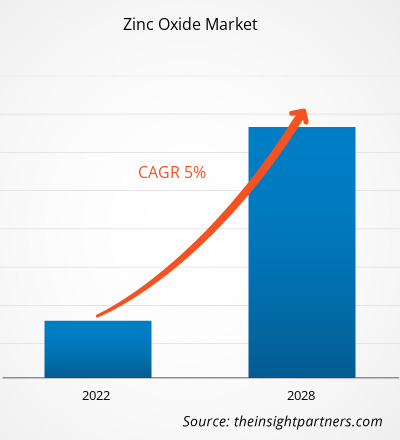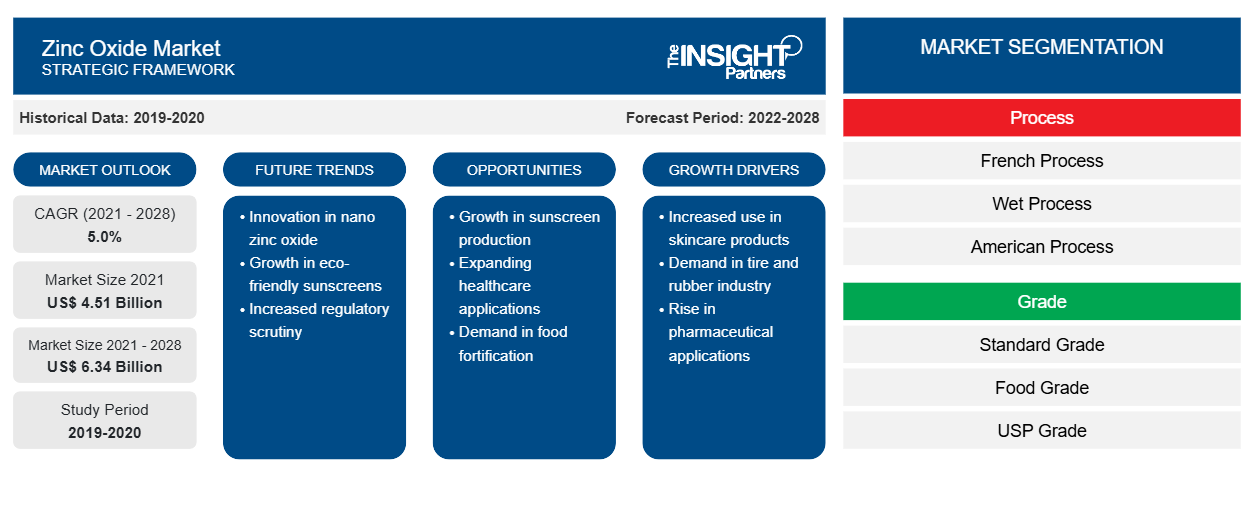El tamaño del mercado de óxido de zinc se valoró en US$ 4.506,51 millones en 2021 y se proyecta que alcance los US$ 6.338,82 millones para 2028; se espera que crezca a una CAGR del 5,0% de 2021 a 2028. CAGR of 5.0% from 2021 to 2028.
El óxido de zinc es un compuesto inorgánico con la fórmula ZnO. Es un polvo blanco insoluble en agua y se utiliza ampliamente como aditivo en numerosos materiales y productos. Además, el ZnO se utiliza para la vulcanización del caucho para aumentar su durabilidad. La industria de los neumáticos también utiliza este caucho vulcanizado para la fabricación de neumáticos. La industria del caucho consumió más de la mitad del ZnO producido en todo el mundo debido a la creciente producción de neumáticos. Además, el aumento de la producción de dispositivos inteligentes y la utilización de óxido de zinc en productos cosméticos y productos de cuidado personal, incluidos el maquillaje, las lociones para bebés, los polvos y los jabones de baño, son los impulsores clave del mercado del óxido de zinc . También se utiliza como agente de carga, colorante y protector de la piel en productos farmacéuticos de venta libre, como el protector solar.
Además, el óxido de zinc se utiliza ampliamente como aditivo para aceites lubricantes de motores de automóviles para reducir la corrosión por oxidación y el desgaste. Los óxidos de zinc se utilizan para fabricar varios tipos de lubricantes, como lubricantes de extrema presión, lubricantes resistentes a las convulsiones y grasas. Por lo tanto, los productos mencionados anteriormente tienen una gran demanda y las respectivas industrias están creciendo positivamente. Por ejemplo, en 2021, la industria cosmética obtuvo alrededor de 81 mil millones de dólares en ingresos en todo el mundo y registró un crecimiento de alrededor del 8% en comparación con el año anterior, según el estudio de Statista. De manera similar, en 2021, los lubricantes para automóviles registraron 70,2 mil millones de ingresos, un aumento de alrededor del 5% en comparación con 2020, según el informe de Statista. Por lo tanto, la amplia gama de aplicaciones del óxido de zinc está aumentando su tasa de consumo y, posteriormente, impulsando el crecimiento del mercado.
Personalice este informe según sus necesidades
Obtendrá personalización en cualquier informe, sin cargo, incluidas partes de este informe o análisis a nivel de país, paquete de datos de Excel, así como también grandes ofertas y descuentos para empresas emergentes y universidades.
-
Obtenga las principales tendencias clave del mercado de este informe.Esta muestra GRATUITA incluirá análisis de datos, desde tendencias del mercado hasta estimaciones y pronósticos.
Impacto de la pandemia de COVID-19 en el mercado del óxido de zinc
La pandemia de COVID-19 provocó importantes perturbaciones en el crecimiento de diversas industrias a nivel mundial. De manera similar, la pandemia de COVID-19 tuvo un gran impacto en el mercado de óxido de zinc en 2020, cuando la cadena de suministro de la materia prima de óxido de zinc se vio obstaculizada debido a la restricción del transporte de mercancías. Las normas de confinamiento flexibilizadas en varios países y la creciente industria farmacéutica sostuvieron la demanda mundial de óxido de zinc. Además de esto, el rápido programa de vacunación contra la COVID-19 y el aumento de la adopción de óxido de zinc para productos medicinales a nivel mundial están impulsando el crecimiento del mercado de óxido de zinc, y los fabricantes de óxido de zinc están experimentando un crecimiento significativo en su negocio.lockdown norms in several countries and the growing pharmaceutical industry sustained global demand for zinc oxide. In addition to this, the rapid COVID-19 vaccinations program and rise in adoption of zinc oxide for medicinal products globally are flourishing the growth of the zinc oxide market, and manufacturers of zinc oxide are witnessing significant growth in their business.
Perspectivas de mercado:
creciente demanda de nanopartículas de óxido de zinc verde en la agriculturaNanoparticles in Agriculture
Con la creciente demanda de alimentos libres de químicos a nivel mundial, el consumo de nanopartículas de óxido de zinc verde está aumentando, ya que es una alternativa segura a los métodos químicos convencionales sin dejar ningún contaminante del aire. Las nanopartículas de óxido de zinc son efectivas para la germinación y mejoran el desarrollo de las plantas. También ayudan a aumentar la tasa de crecimiento del tallo y las raíces sin extraer nutrientes del suelo. La demanda de nanopartículas de óxido de zinc verde aumenta gradualmente debido a sus propiedades revitalizantes del suelo y al aumento del rendimiento de los cultivos.nanoparticle consumption is increasing since it is a safe alternative to conventional chemical methods without leaving any air pollutants. Zinc oxide nanoparticles are effective for germination and improve the development of plants. It also helps boost the growth rate of stem and roots without extracting soil nutrients. The demand for green zinc oxide nanoparticles gradually increases due to their soil reviving properties and increased crop yield.
Perspectivas de proceso
Según el proceso, el mercado mundial de óxido de zinc se segmenta en proceso francés, proceso húmedo, proceso americano y otros. El segmento de proceso francés lideró el mercado mundial de óxido de zinc en 2020. El proceso francés también se conoce como proceso indirecto; en este proceso, el zinc se funde en un horno y se vaporiza a 910 grados. La reacción inmediata del vapor de zinc con el oxígeno del aire produce óxido de zinc.american process, and others. The french process segment led the global zinc oxide market in 2020. The french process is also known as the indirect process; in this process, zinc is melted in a furnace and vaporized at 910 degrees. The immediate reaction of the zinc vapor with oxygen from the air produces zinc oxide.
Información sobre calificaciones
Según el grado, el mercado de óxido de zinc se segmenta en grado estándar, grado alimenticio, grado USP y otros. El segmento de grado estándar lideró el mercado mundial de óxido de zinc en 2020. El óxido de zinc de grado estándar se usa ampliamente en laboratorios, investigación y desarrollo como estándar de referencia durante la experimentación. El óxido de zinc de grado estándar es óxido de zinc puro y de alta calidad.
Perspectivas regionales del mercado de óxido de zinc
Los analistas de Insight Partners explicaron en detalle las tendencias y los factores regionales que influyen en el mercado de óxido de zinc durante el período de pronóstico. Esta sección también analiza los segmentos y la geografía del mercado de óxido de zinc en América del Norte, Europa, Asia Pacífico, Oriente Medio y África, y América del Sur y Central.

- Obtenga datos regionales específicos para el mercado de óxido de zinc
Alcance del informe de mercado de óxido de zinc
| Atributo del informe | Detalles |
|---|---|
| Tamaño del mercado en 2021 | 4.510 millones de dólares estadounidenses |
| Tamaño del mercado en 2028 | 6.340 millones de dólares estadounidenses |
| CAGR global (2021-2028) | 5.0% |
| Datos históricos | 2019-2020 |
| Período de pronóstico | 2022-2028 |
| Segmentos cubiertos |
Por proceso
|
| Regiones y países cubiertos |
América del norte
|
| Líderes del mercado y perfiles de empresas clave |
|
Densidad de actores del mercado de óxido de zinc: comprensión de su impacto en la dinámica empresarial
El mercado de óxido de zinc está creciendo rápidamente, impulsado por la creciente demanda de los usuarios finales debido a factores como la evolución de las preferencias de los consumidores, los avances tecnológicos y una mayor conciencia de los beneficios del producto. A medida que aumenta la demanda, las empresas amplían sus ofertas, innovan para satisfacer las necesidades de los consumidores y aprovechan las tendencias emergentes, lo que impulsa aún más el crecimiento del mercado.
La densidad de actores del mercado se refiere a la distribución de las empresas o firmas que operan dentro de un mercado o industria en particular. Indica cuántos competidores (actores del mercado) están presentes en un espacio de mercado determinado en relación con su tamaño o valor total de mercado.
Las principales empresas que operan en el mercado de óxido de zinc son:
- Zinc permanente
- L. Brügge
Descargo de responsabilidad : Las empresas enumeradas anteriormente no están clasificadas en ningún orden particular.

- Obtenga una descripción general de los principales actores clave del mercado de óxido de zinc
Información sobre aplicaciones
Según la aplicación, el mercado mundial de óxido de zinc se segmenta en caucho, agricultura, productos químicos y lubricantes, vidrio y cerámica, pintura y pigmentos, productos farmacéuticos y otros. El segmento de caucho lideró el mercado mundial de óxido de zinc en 2020. El caucho se utiliza ampliamente en la fabricación de diversos productos, como neumáticos y cámaras de desecho; el uso creciente de caucho aumenta la demanda del mercado de óxido de zinc. El óxido de zinc se utiliza en la industria del caucho para prevenir la decoloración y mantener la estabilidad térmica y la transparencia del producto.
EverZinc; L. Brüggemann GmbH & Co.; US Zinc; Zochem, Inc.; Umicore; Grillo-Werke AG; Rubamin; JG Chemicals Pvt. Ltd.; Pan-Continental Chemical Co., Ltd.; y Akrochem Corporation son algunos de los actores que se centran activamente en el desarrollo de óxido de zinc más innovador para diversas aplicaciones.
Informe Destacado
- Tendencias progresivas del mercado de óxido de zinc para ayudar a los actores a desarrollar estrategias efectivas a largo plazo
- Estrategias de crecimiento empresarial adoptadas por los mercados desarrollados y en desarrollo
- Análisis cuantitativo del mercado de óxido de zinc de 2019 a 2028
- Estimación de la demanda mundial de óxido de zinc
- Análisis de Porter para ilustrar la eficacia de los compradores y proveedores que operan en la industria del óxido de zinc
- Avances recientes para comprender el escenario competitivo del mercado
- Tendencias y perspectivas del mercado, así como factores que impulsan y restringen el crecimiento del mercado de óxido de zinc
- Asistencia en el proceso de toma de decisiones destacando las estrategias de mercado que sustentan el interés comercial, lo que conduce al crecimiento del mercado.
- El tamaño del mercado de óxido de zinc en varios nodos
- Descripción detallada y segmentación del mercado, así como la dinámica de la industria del óxido de zinc.
- Tamaño del mercado de óxido de zinc en varias regiones con oportunidades de crecimiento prometedoras
- Análisis histórico (2 años), año base, pronóstico (7 años) con CAGR
- Análisis PEST y FODA
- Tamaño del mercado, valor/volumen: global, regional y nacional
- Industria y panorama competitivo
- Conjunto de datos de Excel
Informes recientes
Informes relacionados
Testimonios
Razón para comprar
- Toma de decisiones informada
- Comprensión de la dinámica del mercado
- Análisis competitivo
- Información sobre clientes
- Pronósticos del mercado
- Mitigación de riesgos
- Planificación estratégica
- Justificación de la inversión
- Identificación de mercados emergentes
- Mejora de las estrategias de marketing
- Impulso de la eficiencia operativa
- Alineación con las tendencias regulatorias























 Obtenga una muestra gratuita para - Mercado de óxido de zinc
Obtenga una muestra gratuita para - Mercado de óxido de zinc